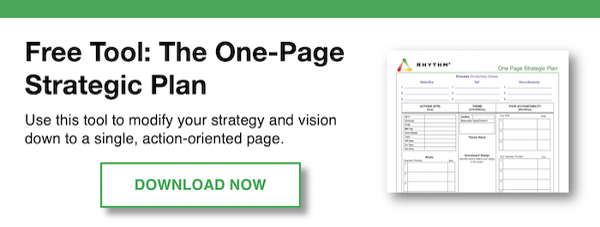Are you fostering an accountability-based team, department, or organization?  Accountability takes a step beyond responsibility. Responsibility is a felt obligation to act within an organization's values, whereas accountability adds that you can be called to answer for your own actions.
Accountability takes a step beyond responsibility. Responsibility is a felt obligation to act within an organization's values, whereas accountability adds that you can be called to answer for your own actions.
In an accountability-based organization, the onus is not only on direct reports (and their reports) to be accountable, but also on managers and executives to produce a culture that fosters accountability in its employees. This can be scary at first, but will pay off in the long run.
The One-Page Strategic Plan (a Mastering the Rockefeller Habits 2.0 or Scaling Up tool) provides an appropriate framework to drive this accountability through our Red Yellow Green success criteria. So, how do you get started? By taking the time and effort to provide a combination of clear, specific, measurable priorities for your direct reports – aligned with company priorities - plus the tools, time, support and training to go along.
Here are five specific attributes of an accountability-based culture:
- People understand what they (and others) are accountable for. When falling short of expectations – there is communication. The communication is heavily weighted toward solutions. Therefore, leaders work with their direct reports to define clear priorities to get them aligned and focused – and on teaching them to move conversations toward solutions when falling short.
- People understand their own (and others') boundaries and decision-making authority; leaders encourage direct reports to exercise discretion and creativity within the defined boundaries.
- Leaders realize current and future potential capability of employees and provide appropriate career development and mentoring to help them reach their potential. We directly offer mentoring for CEOs, team leaders, and team members for our client companies. Look for ways to duplicate this internally – and make leaders accountable and response-able for growing others.
- People are given enough decision-making authority to carry out their work and utilize their strengths. Years ago, Sears determined that many customer complaints could easily be cured at the first customer interface with employees. They determined to empower each front line employee with the power to use his or her best judgment in solving customer issues up to a specified dollar amount. Results were positive, and immediate. What authority should you grant your team members?
- All employees understand how their own priorities help the company achieve its strategy. As a coach at companies ranging from $8M-$20B in revenue, I am often confronted with a lack of alignment toward company priorities and objectives. This is a huge, and often hidden, expense for your company. Even “A” players who work hard, solve problems, and self-initiate will waste energy when there isn’t a clear link to how their effort impacts company strategy.
In an accountability-based company, everyone knows what's expected of them and by when, regardless of whether they are sitting in the staff or management section of the stadium. Clear expectations and accountability for results give us all a better sense of direction. In the words of Stephen Covey, "Accountability breeds response-ability." And, accountability is inherent in the Rockefeller Habits One-Page Strategic Plan tool.
A Colleague Speaks Up!
Colleague and friend Shirley Collins had this to say regarding my thoughts on Accountability and Response-Ability: “I once worked for a company that had a poor first quarter. The President called a meeting with all Vice Presidents - and in this meeting each department had to take proportionate ownership of the quarter's failure.
Each had to identify what wasn’t done, develop a plan, and then communicate to our departments how we were going to have a greater impact in the success of the next quarter. This information was given to the Board of Directors with the assurance that the next quarter would be better.
Suddenly, there was a climate of accountability that trickled down to each employee. Each employee understood his/her role in increasing profitability and was held accountable. They were told to clear their center desk drawer and tape their individual quarterly priorities and tasks in it. Each morning when they reached in to get a pen or pencil they were instructed to evaluate their previous day's performance.
The change in behavior and accountability greatly improved second quarter results.
Going forward, each quarter review saluted and recognized departmental and individual responses. Accountability AND Response-ability made the difference.”
Enjoy the same benefits that Shirley’s company did when you take these five steps to reap the rewards of Response-ability:
-
- Articulate and verify that employees understand their accountability.
- Develop clear boundaries for decision-making authority.
- Assess your team and provide appropriate career development/mentoring.
- Delegate decision-making authority.
- Connect the dots from employee priorities to company strategy.
Click HERE to learn more about how our coaches can help you gain company-wide clarity, focus, and alignment to drive accountability and response-ability.
Want more information on Team Accountability? Check out these additional resources:
The Power of Systems and People: Accountable Leaders and Teams leadership development program to improve team performance.
Take Our Team Accountability Assessment to see how your team stacks up.
Why You Need a Peak Performance Plan for Your A-Players
Accountability Definition in Management
Level 5 Leadership - How to be a Level 5 Leader with examples
Team Accountability Begins with Personal Accountability
How top CEOs Close the Strategy Execution Gap
Follow Up: The Key To Leadership Development
Building Team Accountability: Job Scorecards
10 Signs of an Accountable Culture [Infographic]
Growing Team Accountability in Your Organization
5 Steps to Having an Accountability Discussion [Video]
Learn more about accountable leaders and teams.
Photo Credit: iStock by Getty Images



 LinkedIn
LinkedIn
 Facebook
Facebook
